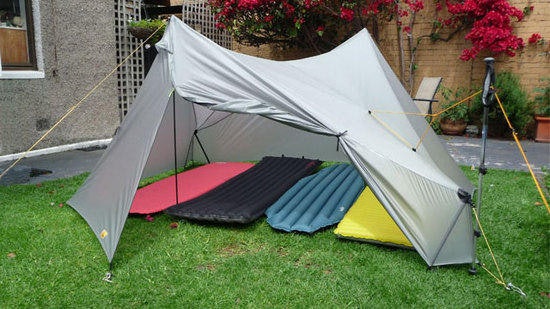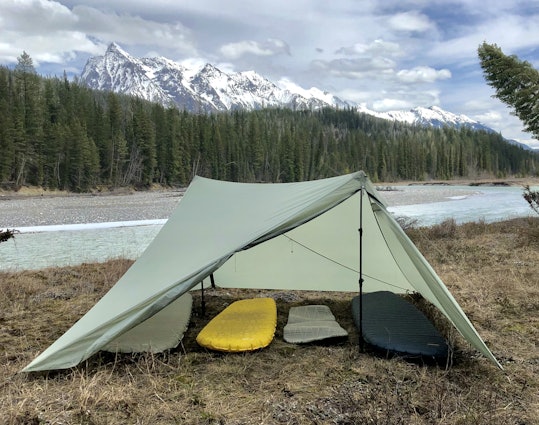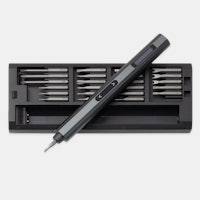Click to view our Accessibility Statement or contact us with accessibility-related questions


























Showing 1 of 3 conversations about:
This tent should be sub 2 lbs. If it's so revolutionary then why would I carry a 2 person, double tent that ways the same or more than all the others? Sorry, not going there.
By
ProAlpine

dandurston
5116
Dan Durston
Mar 21, 2020
The X-Mid 2P is the lightest tent in it's class, but of course there are lighter classes of tents where you could give up substantial function/space/durability to save more weight.
You won't find lighter 2P tent that is also double wall, built of reasonably durable fabrics and has a decent amount of space. To go lighter, you have to buy a tent built with shorter lived materials (e.g 10D nylon), or a singlewall tent (a compromise in wet conditions) or a really small 2P tent. Where the X-Mid excels is at delivering the requisite functionality for a very capable tent at the lowest the weight. Instead of the classic formula of creating a ultralight tent by making an existing design smaller, lower performance or less durable, the X-Mid 2P saves weight through genuinely thoughtful design including the maximally efficient geometry (e.g. minimizing seams, optimal area:volume ratio, optimal pole placement etc). That means it might not be the lightest, but it is the most weight efficient (e.g. function for the weight). I would flip the question around and ask why other lighter tents might be "revolutionary" when they just take a traditional tent geometry and shrink it or gut the functionality for a splashy headline weight spec.
I'll illustrate the weight efficiency of the X-Mid by comparing with some other popular tents that are lighter. First is the "Two" by Gossamer Gear which is 8oz lighter at 28oz. That sounds great and I'm not picking on GG here - it's a nice tent - but it's only lighter because it makes major sacrifices to achieve that. It uses 10D fabric which is substantially lighter but also substantially less durable. The GG Two is also a singlewall so you're not protected from contacting condensation, and then it further skips having any vents, so you're more prone to getting condensation in a tent that doesn't protect you from it. It is also substantially smaller in all regards (length, width, height) and further skimps on the fabric coatings so the HH is much lower (our 2000mm spec is what the fabric tests at after extended wear so it is over 3500mm when new, whereas their 1200mm spec is for their new fabric which would test much lower after wear). Overall, the "Two" is appreciably lighter but there's no geometric innovation that achieved that. It's just the classic formula of taking a traditional tent shape (the A frame in this case) and making it less spacious, less functional and less durable. We could do that too but the X-Mid is intended to be a well rounded tent to excel in all 3 season conditions, while the "Two" is more of a tent for docile conditions.
As another example, MSR has their Carbon Reflex 2 at an impressive 27oz. That sounds amazing because unlike the GG Two, the CR2 is even a double wall. A hiker who doesn't look beyond the headline specs of "27oz/doublewall/2P tent" might think this blows the "36oz/doublewall/2P" X-Mid out of the water. But again there are major sacrifices in performance to achieve a weight like that. The CR2 is light because MSR is using very delicate fabrics (7D vs 20D) so the materials are far less durable. They've further skipped zippers on the fly and instead used clips that save a couple ounces but are widely criticized in reviews for blowing open, letting rain through, and being hard to use. Most notably though, it's light because it's an incredibly small tent for two: it's a full 10" lower inside (you can barely sit up 1 at a time). Then it further skips useful features like vents, plus goes ultra-minimal on the waterproof coatings which is why a leaking fly even when brand new is widely reported and acknowledged by MSR as a real problem (see here). All of that adds up to a tent that OutdoorGearLab says is "not suitable for three-season storms". So it is appreciably lighter but again it's not through clever innovation but just by sacrificing as much as it can. In doing so, it has become a niche tent for conditions where you hardly need a tent. The X-Mid also focuses on saving weight, but not at the expense of core functionality like keeping rain out. Unlike the CR2, X-Mid 2P has robust fabric coatings, fly first pitch, protected entry ways, no sag fabric, generous vestibules, ample space for two, more durable fabrics, proper zippers, peak vents, etc. You gain an enormous amount of performance and liveability for those extra 9oz. If you need a true 3 season tent, it's not even a comparison.
One last comparison is the Six Moon Design's Haven. The Haven is double wall, 2P, dual trekking pole tent. It's a nice tent and might get you asking why the X-Mid is special because the Haven looks sorta similar and weighs only 34oz instead of 36oz. However, that weight gap closes to about 1 oz when you consider the Haven needs seam sealing (it's not factory seam taped like the X-Mid) and it requires 2 more stakes So it's roughly 1 oz lighter and that's for a tent that is substantially narrower (44 vs 50" wide), shorter, and has a lot less headroom (because the poles aren't offset), plus it further saves weight through shorter lived #3 zippers like GG's The Two. I think it's remarkable that for only ~1 oz more, the X-Mid 2P offers a much larger space that is comfortable for two, more durable zippers, better vents, larger vestibules etc. The X-Mid 2P also has much better snow shedding performance (because the Haven has larger/flatter roof panels), simpler pitch, larger doorways, no sag poly fabric etc. On top of that it costs quite a bit less while using higher end materials and hardware like YKK AquaGuard zippers because there's a lot less markup on the X-Mid.
As these examples show, it's easy to make a tent light by making it smaller/limited function/less durable. Those tents often sell well because buyers look at the weight specs without considering what do you get for the weight and then end up disappointed in the field. Instead of looking only at the weight, I think it's best to consider what functionality you want to have in a tent, and then look for the tent that delivers that at the lowest weight. This won't be the absolute lightest tent, but it will be the most weight efficient tent (e.g. delivering the requisite function for the least weight). For anyone that needs a true 3-season tent with attributes like decent space, legit stormworthyness, reasonably durable materials etc, that answer is likely the X-Mid.
To illustrate how the X-Mid excels against tents that try to achieve this same aim, a much more comparable tent is the TarpTent StratoSpire 2. The SS2 is a highly regarded tent because it's a well rounded solid performing tent. It's a nicely sized tent for two, double wall, uses reasonable #5 zippers, durable fabrics, has vents etc. I've owned an SS2 and put hundreds of nights on it. It's a great, solid tent but still has some limitations like nylon fabric (sags when wet, absorbs a lot of water weight), tiny vents that are often crinkled shut from being packed, a complicated pitch, and corner struts which add weight and make it awkward to pack (e.g. won't store horizontally like the X-Mid). The total weight for this capable and well rounded tent is 42oz, so it's 6oz heavier and that's not considering you need to seam seal the SS2 and use more stakes so the actual weight difference is closer to 8oz (and then the nylon SS2 further gains more water weight in use). So the X-Mid is appreciably lighter while solving the main downsides of the SS2 (complicated pitch, hard to pack struts, ineffective vents, saggy nylon) plus it includes pockets inside the tent and comes factory seam taped (versus user seam seal). So you're getting at least as much function - arguably more - for a substantial 8oz less. Besides the function list, the X-Mid is a nicer to use tent because the poly fabric doesn't sag when wet (like nylon), it's a much simpler pitch, has one-handed zippers, and it can pack really short (stores horizontally in a pack).
How does the X-Mid deliver the most weight efficient tent? Through genuine innovation. It uses a unique and patent pending geometry that gives it a fundamentally more weight efficient shape and with fewer seams. It gets more volume from two poles by positioning them further apart and using a unique double diagonal design to make it all work inside a simpler rectangular fly shape. The superior area:volume ratio means less seams, less stress points to reinforce, and less fabric for the volume. Moving the poles further apart also gives steeper walls to solve the need for struts. It's a good (revolutionary?) design because it saves weight through novel engineering rather than chopping features, size and durability.
To wrap it up, we could easily get it sub 2 lbs if we shaved off useful features, used really delicate materials, and made it really small. That would look cool on a spreadsheet and would work well for some people, but I don't think it would be a better overall tent. The X-Mid is aimed at being high performance tent at the lowest weight, not just the lowest weight irrespective of performance. For people that are interested in a lightweight yet capable tent, I think it is a compelling design.
(Edited)
ProAlpine
51
Mar 21, 2020
dandurstonAwesome insight. Thanks for taking the time and giving me (and most likely others) some great background into materials and design. I'd buy it right now if I weren't unemployed due to the coronavirus!
Cheers,
Rdahlgren
13
Mar 24, 2020
dandurstonAND, you can pitch the tent using just the fly and leave the inner tent at home. Spacious, with about 62 square feet and weighs less than 1.5 pounds.

Girryn
17
Mar 24, 2020
ProAlpineDan has owned or used most of "the competitors" at some point and been disappointed. This Holy Grail is the result of his dissatisfaction.
ProAlpine
51
Mar 25, 2020
dandurstonDan, can you give some insight into the mesh material used in the tent. Most tent manufacturers are using mesh for the tent body to save weight these days. I've shied away from this design recently because I tent to do a fair number of desert trips each year and with wind and sand it can feel like you're sleeping in a sandblasting box. I know not all mesh is the same though. Some is finer than others, some is more durable than others. Where does your tent mesh material fit in? Thanks

dandurston
5116
Dan Durston
Mar 25, 2020
ProAlpineGood question. A double wall tent can use mesh, solid fabric or some combination of those two ("partial solid inner"). Any material provides the basic double wall advantage of restricting you back from the fly so you aren't inadvertently contacting condensation on the fly. Solid fabric is more stormworthy though in the sense that it will block more sand, wind and spindrift, and it also blocks any mist/splatter that you might get if there is condensation on the fly and then wind gusts shake the tent. So it is clearly more stormworthy which is why in many parts of the world a solid fabric is strongly preferred (e.g. Europe).
The problems with solid fabric are (1) it tends to be heavier, (2) it feels more confined/small because you can't see out nearly as well, and (3) it's quite a bit warmer due to added insulation and draft blocking. That warmth is an advantage in cooler weather, but the tent can be unbearably hot in the summer yet to can't open it up because of bugs. Some will have mesh and solid fabric in some areas that you can zip open as vents, but then you're adding mesh and zippers so the weight goes up. Thus, folks in colder climates tend to prefer solid fabric tents while mesh is much preferred in hotter climates and in the summer. In the USA desert it can be a tough call because you want to block that sand, but sometimes it's really hot too where a solid inner gets pretty brutal without a breeze.
So solid vs mesh inners serve different purposes, and ideally we'd offer both. I'd like to do that but I haven't been able to convince Drop to invest in a solid inner yet. Many brands offer both (e.g. TarpTent) while other brands (e.g. MSR) tend to go the "partial solid" route by adding a foot or two of solid fabric around the base of the inner and then mesh in the upper half, which splits the difference and they sell that in all markets. Currently we just have the mesh inner option which most people will prefer in the summer and for a general purpose tent, but it does make it less winter suited.
The specific mesh we are using is pretty light. The size is a noseeum mesh so it's about as fine as it gets, but this size of mesh is pretty common nowdays (e.g. more coarse mosquito netting is rare). Our noseeum mesh is light for a noseeum mesh (e.g. 0.5oz/yd) because the actual strands are thinner. It's still durable in the sense that it would be quite rare to rip it, but these lighter strands do dis-lodge more easily from where they should lay, which appears to be damage (or a "pull" in the netting) but can actually be worked back into place by scratching with a bit of pressure.
MSR has a nice video on this here:
https://www.youtube.com/watch?v=maaChyqfyaA
And I've got a short video clip here demonstrating this on the X-Mid mesh:
https://www.youtube.com/watch?v=qTLusQHAy4M
So to sum it up, the mesh has about as fine of holes as you can get, using lighter strands that are durable in the sense that tearing it would be rare, but the lighter strands do dislodge more easily. If they dislodge it almost never allows bugs in, so you can ignore it, fix it, or take steps to prevent it (this mostly happens when packing up the tent and sticking velcro to the mesh).
ProAlpine
51
Mar 25, 2020
dandurstonThanks for the comprehensive reply! I would certainly be interested in a solid liner option, especially if it could be purchased separately to compliment the mesh/fly tent one might already have. Being a mountain guide, I'd love to have a lightweight 4 season tent that's easy to set up, has plenty of vestibule storage, and room for 2. Maybe there are others on here who'd like a solid wall inner for sand, snow, etc...

dandurston
5116
Dan Durston
Mar 25, 2020
ProAlpineThere are lots of interested people in a solid inner. We were going to do a solid inner for the 2P but Drop was worried about demand - mostly I think because they are in California where solid inners are much less popular than over in Europe or Australia. Outside North America the majority of tents seem to be solid inner. I'm continuing to ask them to do it, so it might happen someday and if so, might be available as the inner only for folks that already own mesh. Hard to say what will happen.
Swift3
3
Mar 27, 2020
dandurstonI own, and use, and really like, my Henry Shires' Tarptent SS2. But as you point out, silnylon has a sag when wet issue. The SS2 does have some other advantages, like being about to re-configure it to expand to accommodate 3 or 4 normal sized sleeping pads in a pinch. That said, I just ordered the X-Mid 2P, primarily because of the slight weight savings and the PU material. I also like the additional guy-outs along the edges which can help make this tent super strong in a higher wind setting.

dandurston
5116
Dan Durston
Mar 28, 2020
Swift3The SS2 doesn't actually have an advantage in fitting 3 or 4 pads. Partially the X-Mid can do some of these things too, but also the SS2 can't actually do as much as TarpTent claims.
Whoever does the specs on TarpTent's website seems to be pretty relaxed about it, so the specs are often inaccurate and/or contradictory. For example, for the longest time they had the "max interior height" of the SS2 listed at 50" which can't be right if that's the inner height because the instructions say to set the poles to 50" and thus 50" is the peak fly height and the inner must be a few inches lower. Confirming this, their setup PDF says the inner height is 48" and even that is optimistic because it really measures more like 45".
I was talking with them and pointed out that the interior height can't be 50". They agreed it was wrong but kept the 50" spec and changed "max interior height" to "max interior height (under fly)". That might be technically true but it is still widely misunderstood as being a spec for the inner height. People looking at the specs would think the SS2 has a nice edge in headroom vs the X-Mid 2P, when actually both tents are virtually identical at 44-45". There's all sorts of other inaccurate and/or contradictory specs on their website, including the topic at hand of fitting 3 or 4 pads.
To fit 3 pads, the TarpTent website says the SS2 floor can widen to 62" by loosening the inner at the peaks but that is not accurate. The SS2 actually reaches a max floor width of about 56" in the widest possible scenario so the 62" spec is substantially inaccurate. I don't think this is anything intentionally deceptive - rather I suspect what happened here is that someone behind a keyboard said "hey the floor is 52" wide and the two side walls are 5", so if you loosen it right off it could be 62" wide!" without considering that there isn't nearly that much adjustability at the peaks. You can only loosen it about 2" inside each peak, so there's no way you can loosen the walls flat to 62". Further, during a regular pitch the floor only measures 52" wide if you're really pulling it tight - it's an optimistic spec - with 49-50" being more realistic. So really the floor is 49-50" and can loosen to about 54", with maybe 56" in the best case scenario.
That's virtually identical to the X-Mid 2P. We could also claim the floor at 52" since it is that wide with perfect tension/no wrinkles but we've chosen a more realistic spec of 50" because that represents normal use. Like the SS2, there is 2-3" of adjustability inside the peaks (I think a bit more than the SS2) so you can also lower those to expand it to 54" and maybe 56" at most. These two tents are virtually the same in this regard.
So how can the SS2 fit three regular width pads as TarpTent claims in their FAQ ("The interior will widen to just fit three standard width sleeping pads") and demonstrates in their image below? It can't. Notice in their photo that the pad at the back is actually curved up the side wall, while the closest pad is on top of the middle pad by a couple inches, and the other pads also overlap a bit. That floor isn't more than 54" wide (you can see 3-4" of sidewall, which wouldn't be there if the floor was >60"). Thus you can cram three pads in, but it's a stretch to say they "fit" when the floor isn't wide enough for all three to lay flat.




(Edited)
Swift3
3
Mar 29, 2020
dandurstonThanks for the lengthy comparison. For my use, it's good to know that the X-Mid has roughly, or even more, of that emergency capability. But in either, the SS2 or your design, I'd hope it's just a sort of emergency use only feature. I'd hope most won't want to jam in 3 full grown folks in the inner, maybe 2 and a child, and a small child at that, or 4 under the fly unless 2 others camping partners had a total tent failure in the middle of a huge blow and there was no other way to stave off hypothermia. But it'd be a long and rough night. So, yea. Good points all. But it's the poly v silnylon that I really liked. I'm hoping I won't be carrying a bunch of absorbed water all morning until lunch when, assuming the sun shows, I could spread the silnylon out to dry. With the poly, one chore should be eliminated, and every thing that makes less work is good in my book. Looking forward to using it for many years. And great to know it too will have that emergency capacity. Well done!
JeremyS78
18
Apr 1, 2020
dandurstonNothing out there touches this thing, especially for the $

mgardneraa
60
Apr 2, 2020
dandurstonDan, as an owner of of both the 1 and 2 X-MID I'd like to second your response about weight. There is the worthy but sometimes overdone pursuit of lightweight. This leads to stupid light (Skurka blogs about it) and what I saw some years ago in mountain biking - dangerous light. In the quest for lightness, mountain bikes were being equipped with components that broke under typical stresses causing injuries and worse. In the tenting world we've seen lightweight gear not able to handle conditions. It all comes down to what do you need (not want...) I need a durable, lightweight enough shelter with features that are appropriate at a price that is affordable. If $500-700+ is affordable, good on you mate. Just don't get into the realm of stupid or dangerous lightweight or SAR may be necessary. Otherwise, I hope you have a great time and see you outside, but not too close ;/

dandurston
5116
Dan Durston
May 4, 2020
Swift3Here's a photo of 4 pads in the X-Mid 2P. Sleeping four not only actually works but fits well enough that it isn't crazy. It works quite a bit better than the SS2 because of the rectangular shape of the tent fly.
In this photo the outer two pads are regular sized (20" x 72") while the inside two pads are smaller because it's all I had, but 4 regular pads would fit no problem. There is the same length all the way across and plenty of width. Theoretically you can even fit 4 long/wide pads but that's pushing it.


(Edited)

Skylerray
1
Jul 6, 2020
dandurstonWow, fantastic write up. Thanks, Dan.
ProAlpine
51
Aug 10, 2020
dandurstonJust placed my order!

dandurston
5116
Dan Durston
Aug 10, 2020
ProAlpineNice! I hope you like it. These should be shipping out a bit early. In case it's helpful, my pitching guide is here:
https://www.youtube.com/watch?v=cVboRcwY6P0

Bizzy_B
61
Aug 15, 2020
dandurston@dandurston
Just “dropping” a big THANK YOU for designing in such a thoughtful and meaningful way. Your expertise and passion is wonderfully evident in your creations and in your posts.
Nothing stokes me more than finding awesome things to help live a happy & healthy lifestyle, while supporting such a classy character!
Loving my 1P & can’t wait for the 2P to arrive soon!
Keep doing your thing brother!! 👍🏻👊🏻

dandurston
5116
Dan Durston
Aug 16, 2020
Bizzy_BThanks a lot! Glad to be involved in trying to make great stuff and it's nice to hear when people like it.

runulv
1
Nov 20, 2020
dandurston@dandurston I have both 1p and 2p versions of your tent and they are just awesome! So thank you for that :)
I got a question though, did I hear a rumour of solid inners for them? That could be interesting

dandurston
5116
Dan Durston
Nov 20, 2020
runulvThere's quite a bit of interest in a solid inner so that's something I'm looking into and trying to find a way to make it happen. I hope to do it eventually but it's unclear whether that would be a version through Drop or an accessory I offer at DurstonGear.com. Either way, it won't be ready too soon (next fall at the soonest).
Ntuttle15
2
Mar 1, 2021
dandurstonHey Dan! Just wanted to say I'm dying to get my hands on a 2p tent! Don't exactly know the most appropriate place for this comment but I (and I'm sure others) can't wait to get a new stock! when can we expect to see anything?

dandurston
5116
Dan Durston
Mar 1, 2021
Ntuttle15The next batch arrived with Drop last week. I expect them to crack open orders any day now.
PRODUCTS YOU MAY LIKE
Trending Posts in More Community Picks

Graham88
Completely surprised by the lack of blade diversity here on Drop...
I’ve been a collector of Blades since before my teens, and a retailer coming up on 15… or maybe 20 years. Drop has really been kind of an interesting experience for me, because I do occasionally get to see some unusual tech and sometimes EDC items that otherwise I might not have been aware of. And maybe it’s because I have a deep love of cutlery and bladed weapons, but I find myself trolling through the site looking at it what’s available; and it’s just it’s pretty much the same. And the bladed community here is just always confused me.. every single knife is about the same, they’re almost all drop points and although the handle materials change and brands change.. it’s really just the same knife over and over and over again... occasionally you’ll see a tanto or a slight variant; but rarely… and almost never a serrated blade. And I’m just deeply amazed at this diversion of serrated blades. And I’m just surprised there isn’t more of a request for diversity here.... and I...
Mar 12, 2020
JellyDPhoto
Can we get Sony E-Mount or other mirrorless camera options please..
Would be nice to see some Sony E mount full frame cameras on here. I currently shoot with a A99 and they killed the lense path for better or more option lenses and now is all E-Mount. 🤔
Jan 13, 2020
RayF
There Are Pandas, and Then There Are Pandas.
And this isn't either of them! The Pandas we're talking about here, are watches, not bears. And what got me thinking about them (again) was a link posted this morning by @cm.rook who pointed a few of us to the very attractive (and not terribly priced) Yema "Rallygraph" Panda which, in it's most traditional arrangement, looks like the one on the left, but can also be had in the version on the right: The model on the left is a true Panda, while the model on the right is called a reverse Panda. The reason for that distinction is clear--Panda bears, only come in the first arrangement. Now at this point, everyone should be thinking about the most well-know Panda, The Rolex Panda, which is actually a Daytona, and among Rolex Daytonas, the most famous of which is the Paul Newman Daytona, which was famous first, because it was Paul's, and second because it sold at auction for $17.8 million (US Dollars). The story of that auction is well-known so I'll only...
Nov 8, 2019




